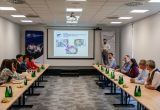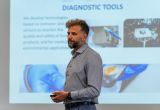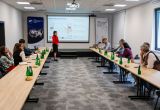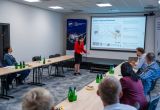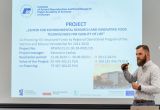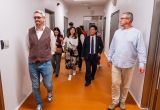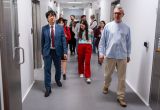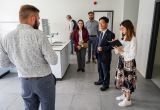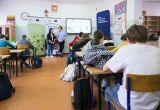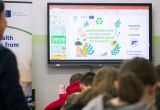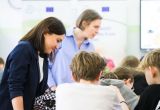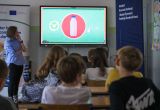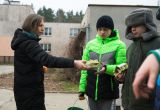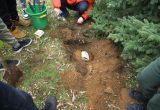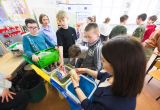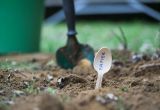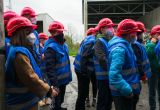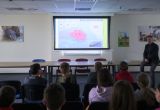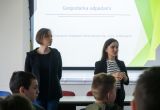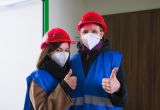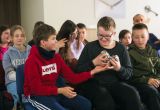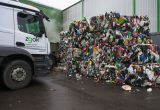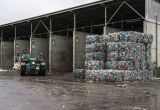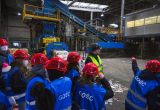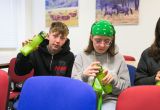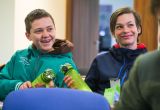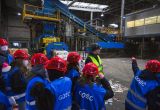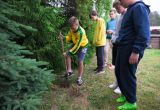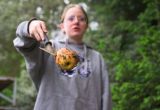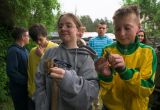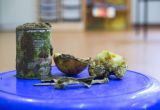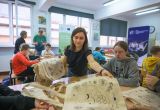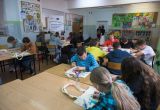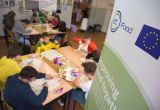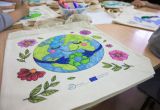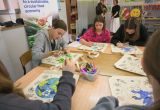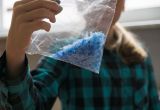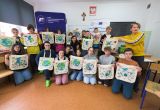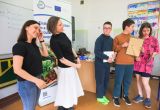EN
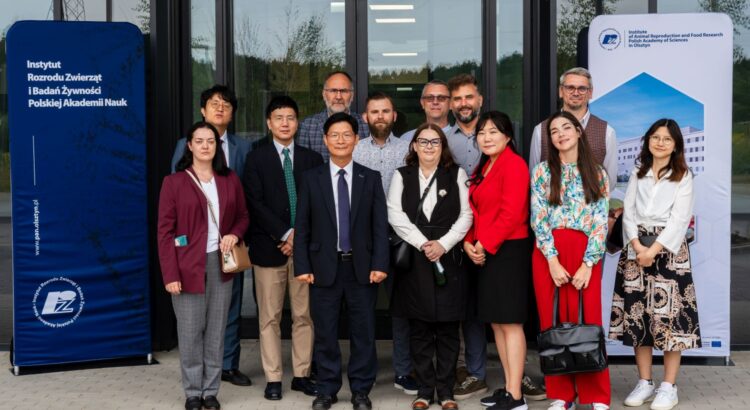
Representatives from the Korean Agri-Food Technology Promotion Agency KOAT visited the Institute
At the end of August, we hosted representatives of the Korean Agri-Food Technology Promotion Agency KOAT at our Institute. Research, offers designed for business and the Institute’s international projects were discussed at the new headquarters.
The aim of the delegation was to strengthen relations with local entrepreneurs, government authorities and scientific and research institutions that are working on the agri-food market development, taking into account the characteristics of the region and the challenges of the food chain. The visit of the Korean delegation to the region was coordinated by the Marshal’s Office of the Warmia and Mazury Voivodeship.
– Poland is already in seventh place in the ranking of countries with which South Korea cooperates. Increasing imports and exports from both countries are observed. Our country is listed among those with the greatest potential, the Marshal’s Office highlights.
During their visit to the Institute, guests from KOAT had the opportunity to learn about the areas of work of our scientists, including activities for high-quality food, one of the smart specialisations of our region. Cooperation with business is an integral part of the Institute’s activities, as the guests found out when they got to know the core facilities – laboratories that offer external entities and companies research resources, access to equipment, technology or specialised consultations – all according to their needs and at the highest level.
– We are delighted to have hosted the KOAT representatives at our new premises, where we had the opportunity to present the level, but also the scale, of our activities, including those in the international arena. We hope that this visit will result in future joint activities in areas related to food and its production – says Michał Żurek, General Affairs Director.
Photo W. Fabiszewski

Researchers: functional foods to help prevent lifestyle diseases
Products that support the digestive tract or reduce the risk of overweight and obesity – consumers are increasingly looking for value-added foods with extra health benefits. Scientists see this trend as a chance to prevent noncommunicable diseases (NCDs).
– There is a growing body of research that points to the beneficial effects on human health of specific substances present in and added to foods. These include probiotics, prebiotics, vitamins, dietary fibre, but also natural antioxidants, minerals or good fats from the omega-3 group. Manufacturers are even outdoing each other in creating innovative proposals, because consumers expect this, which results in the development of the functional food market – emphasise food researchers from the Institute of Animal Reproduction and Food Research of the Polish Academy of Sciences in Olsztyn, Dr Joanna Fotschki and Dr Lidia Markiewicz, in an interview for Science in Poland news platform.
They add that there is also scientific evidence that functional food ingredients can have an impact on the prevention of chronic diseases, cardiovascular diseases, gastrointestinal disorders and neurological diseases.
– It is in functional foods that help in the prevention of civilisation-related diseases, e.g. diet-related diseases, including supporting the maintenance of proper body weight and alleviating the consequences of metabolic disorders such as diabetes – they point out.
Both scientists work in the Team of Immunology and Food Microbiology of our Institute, where they research the impact of dietary ingredients contained in food on the human body, e.g. on the immune or digestive systems.
Currently, Dr Lidia Markiewicz is leading a task in a project on combining fruit ingredients with vegetable ingredients or with a postbiotic (i.e. a bioactive ingredient made from probiotic bacteria) to increase the nutritional and health-promoting values of such mousses. Dr Joanna Fotschki, on the other hand, is concerned with the development of functional food additives derived from food processing by-products, i.e. raw materials that are not used by industry on a daily basis.
Functional foods are new foods that have been developed to have a positive effect on the body. – In order to be considered functional, a food must contain – in addition to natural ingredients – an increased concentration of some active substance that does not naturally occur in the food in question or is present in small amounts. The simplest example of a functional food, which has been known for years, is iodised salt, as an adequate dose of iodine is necessary for the production of thyroid hormones – says Joanna Fotschki.
She adds that it can also be a food without an ingredient, e.g. gluten, lactose, sugar or salt. In addition, the latest definitions also take into account the content of live micro-organisms with potential health-promoting or disease-preventing effects. An example is yoghurt drinks, where there are billions of live bacteria cultures in a single bottle.
The most popular products include dairy products (e.g. yoghurt), cereals, drinks or bars. – We can divide them into products aimed at a selected group of consumers, e.g. pregnant women or athletes, or into product categories in terms of the effect we want to achieve, e.g. supporting the functioning of the digestive tract, counteracting stress, reducing the risk of overweight and obesity – says Joanna Fotschki.
Compared to dietary supplements, functional foods are often better absorbed. – Nutrients found in food and consumed as part of a meal are often more bioavailable than supplements in the form of capsules, tablets, gels or powders. This means that our bodies are better able to assimilate the nutrients and thus benefit more from functional foods, in which the bioavailability of these nutrients is higher – emphasises Joanna Fotschki.
At the same time, Lidia Markiewicz reminds us that in order to obtain the health-promoting properties of functional foods, one must wait for the effect – it will not happen immediately after consumption. – It is also worth mentioning that you should choose functional products with the lowest possible level of processing and the presence of bioactive compounds with scientifically proven effects in their composition – she adds.
When asked about trends in functional foods in global science, Lidia Markiewicz points to several research directions: research into dietary fibre (food fortification and the search for/characterisation of new sources of fibre, including from food production side streams, i.e. from cocoa bean husks, grape pomace or legume hulls, for example), fermented foods and ‘good fats’ (e.g. omega-3 fatty acids).
– The increasing interest in functional foods is mainly due to the growing awareness of consumers, and these consumers, having easy and wide access to information (internet, social media), are looking for value-added foods, the consumption of which will bring them additional benefits. Probably the key in this phenomenon is precisely the access to information, however, the source and reliability of which are not always verified by consumers. This is why the role of food producers is so important here, so that the information they place on packaging does not follow what the consumer wants to read, but provides reliable information about the product and its ingredients – points out Lidia Markiewicz.
– I think that soon, under pressure from consumers, even “ordinary” food will have to have certain features assigned or highlighted in order to compete with functional food, while “ordinary” food of good quality is already in itself a source of valuable nutrients and health-promoting ingredients – she adds.
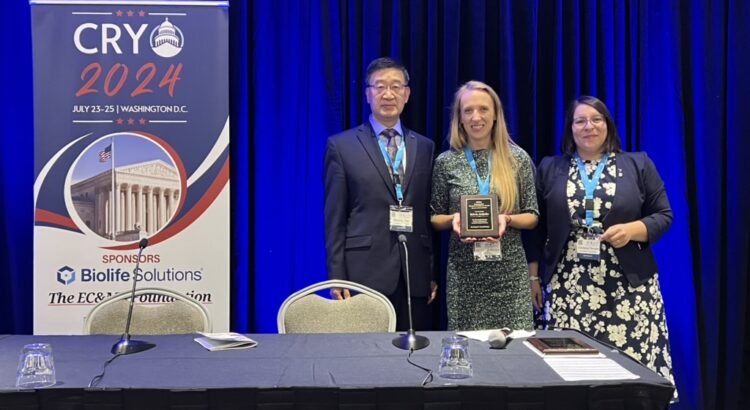
Sylwia Judycka is the winner of the 2024 Dayong Gao Young Investigator Award
Established in 2019, the Dayong Gao Young Investigator Award (DGYI) is the Society for Cryobiology’s prestigious award for excellent researchers who are in the first 10 years of their post-doctoral career. This year’s winner is Dr. Sylwia Judycka from the Team of Fish Reproduction and Development of our Institute.
The aim of the award is to foster and encourage early career cryobiology researchers. The DGYIA is open to cryobiology researchers from around the world. The award carries a cash prize, sponsored by GoldSim, as well as a special lecture and registration waiver to the Society for Cryobiology’s annual meeting.
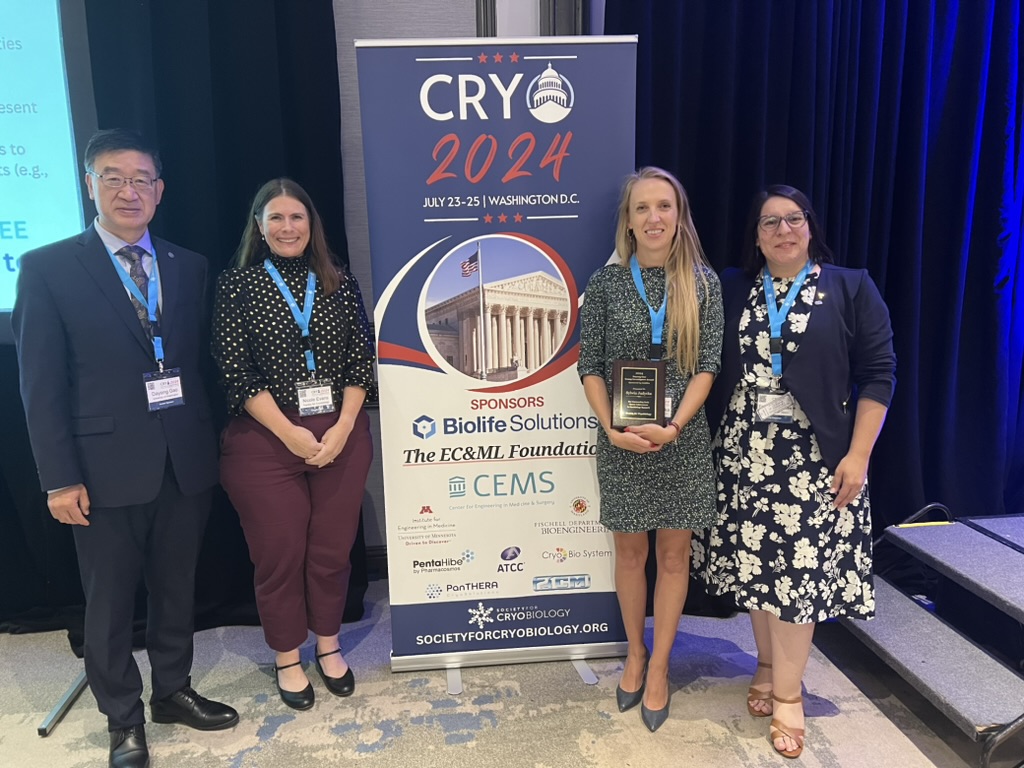
Dr. Judycka’s research concerns effective methods of preserving the biodiversity of native fish species, which is extremely important today in the face of climate catastrophes. In her research, she uses the cryopreservation technique, which involves storing fish semen at low temperatures, but ensuring that sperm remain viable after thawing. She and her team have demonstrated the effectiveness of this technique for salmonid and perch species. The point of the developed procedures has been confirmed by the high results of egg fertilization using cryopreserved semen.
„One hallmark of Dr. Judycka’s work is the establishment of a comprehensive sperm cryobank housing genetic material from a diverse array of fish species. This includes sex-reversed female rainbow and brook trout, rainbow trout variants (both spring and autumn lines), Atlantic salmon, whitefish, sea trout, grayling, carp, and Atlantic sturgeon. These repositories serve as invaluable reservoirs of genetic diversity, safeguarding the future of endangered species and bolstering breeding programs” – we read in the CRYO2024 Conference Book.
Congratulations!

Fermented beetroot and red cabbage beneficial for diabetics
Introducing fermented beetroot and red cabbage into the daily diet may be helpful in the prevention of diet-related diseases and may protect against chronic inflammation in these diseases, scientists from our Institute have shown. The researchers looked at biologically active compounds capable of inhibiting the process of protein glycation. This process, which is one of the features of diabetes, leads to the intensive combination of sugar with proteins, which are then deposited in cells, negatively affecting their function.
This is the first study to show a link between the content of individual bioactive compounds (phenolic acids, flavonoids, anthocyanins and betalains) and antiglycation properties following spontaneous (i.e. spontaneously occurring) fermentation of beetroot and red cabbage.
– We have shown that the fermentation of these vegetables had a beneficial effect on the content of those components that have the ability to inhibit protein glycation. After all, the accumulation of Advanced Glycation End-products (AGEs) is one of the key mechanisms leading to diabetic complications, such as nephropathy and diabetic retinopathy – emphasises study leader Dr. Małgorzata Starowicz, acting head of the Team of Chemistry and Biodynamics of Food at the Institute of Animal Reproduction and Food Research of the Polish Academy of Sciences in Olsztyn.
THE POWER OF NATURAL COLOURS
Beetroot and red cabbage are popular in Poland not only for their culinary tradition, but also for their numerous health benefits. Rich in antioxidants, vitamins, minerals and fibre, they support the health of the heart, cardiovascular, immune or digestive systems, making them valuable components of a healthy diet.
Beetroot owes its characteristic colour to betalains and red cabbage owes it to anthocyanins, natural pigments which, in addition to their colouring properties, have numerous health-promoting effects, including being powerful antioxidants (neutralising harmful free radicals that have a negative impact on the body, e.g. by contributing to faster ageing).
Another property of antioxidant compounds (antioxidants) is that they do not cause sugar to combine with proteins (glycation), resulting in excessive sugar accumulation in the body. This process intensifies during hyperglycaemia – one of the features of pre-diabetes or diabetes itself.
BENEFICIAL FERMENTATION
Combining these issues, the researchers wanted to test whether the fermentation process of beetroot and red cabbage increases their anti-glycation properties. And they demonstrated that this is indeed the case.
– Fermentation of vegetables has significantly increased the bioavailability and thus the biological activity of key bioactive compounds. Raw vegetables have a naturally high content of bioactive compounds, but their bioavailability in the human body is limited by, among other things, the tight bonds between these compounds and the plant cell structure. The fermentation process breaks down these structures, releasing the bioactive compounds. Furthermore, the fermentation process leads to the formation of new beneficial metabolites. As a result, fermented beetroot and red cabbage have stronger antioxidant and anti-inflammatory properties, making them more effective in diabetes diet therapy, compared to their raw counterparts. It is important to understand these processes in order to be able to optimise the fermentation conditions to increase the health benefits of the final products – points out study co-author Dr. Natalia Płatosz from the Team of Chemistry and Biodynamics of Food at the Institute of Animal Reproduction and Food Research of the Polish Academy of Sciences in Olsztyn.
Why fermentation? – Fermentation, which is one of the longest known natural methods of food preservation known to mankind, is returning in favour and becoming very popular. In addition to the most popular pickled cucumbers or sauerkraut in Poland, we are opening up to new flavours, such as kimchi. In our study, we also wanted to show that our local vegetables subjected to the fermentation process gain not only a unique taste and texture, but also a number of health-promoting benefits, which may increase their attractiveness and encourage consumption of larger amounts of these products – explain the researchers.
FERMENTED FOODS AND DIET
In their view, this knowledge can benefit both consumers and food producers.
– Increased awareness of healthy lifestyles among the public may make fermented products increasingly popular, especially for people with diabetes or pre-diabetic conditions. In the context of food processing, fermentation is one interesting technique to further increase the bioavailability and health benefits of bioactive compounds contained in fruit and vegetables. Therefore, collaboration between researchers and food producers on the fermentation process and the impact of fermentation end products on human health is essential and can lead to the development of new, innovative products that meet the high expectations of consumers. Such products can be promoted as part of a diabetic-friendly diet and thus increase their market value – the researchers emphasise.
The findings were published in the journal ‘Foods’ . This is basic research, conducted in vitro. However, the authors do not rule out continuing and conducting further stages of research, including with humans.
– We have shown that the introduction of fermented beetroot and red cabbage into the daily diet can be helpful for prevention and protect against chronic inflammation in diet-related diseases. However, we should remember that the consumption of raw as well as fermented vegetables should be combined with a balanced diet and, if necessary, appropriate treatment, the researchers conclude.
Anna Kononiuk with a scholarship for outstanding young scientists
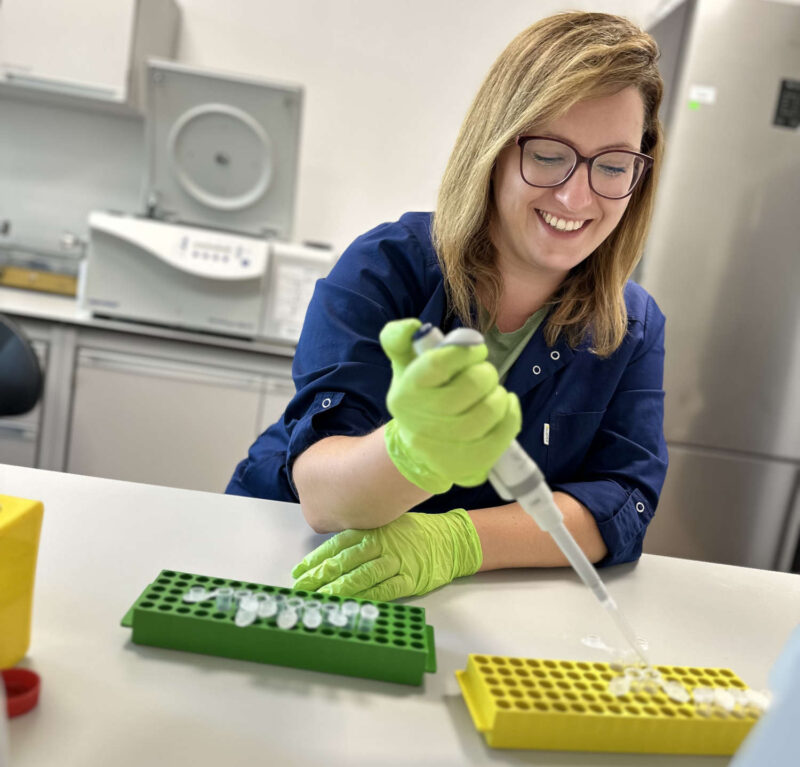
Dr. Anna Kononiuk from our Institute received a scholarship from the Minister of Science and Higher Education for outstanding young scientists. Her research focuses on the potential of deer meat as an alternative to commonly consumed meat species.
The ministerial scholarship program for outstanding young scientists can be awarded to a person conducting scientific activity who is a doctoral student or academic teacher and does not have a doctoral degree, or to a person with a doctoral degree that has been obtained within 7 years.
In the last edition, the Minister awarded scholarships to 228 outstanding young scientists representing 53 scientific and artistic disciplines. This time, 1,708 applications were submitted to the competition: https://www.gov.pl/web/nauka/ponad-44-mln-zl-dla-228-wybitnych-mlodych-naukowcow
The main scientific goal of Dr. Anna Kononiuk’s is to demonstrate the potential of deer meat as an alternative to commonly (conventionally) consumed meat species.
– Meat of animals classified as cervids (including red deer, roe deer, fallow deer) is a very valuable raw material compared to beef, pork and poultry popular on Polish tables. This is due to both nutritional and health considerations (incl. a higher content of iron and antioxidant compounds) as well as ecological considerations (incl. the fact that their breeding is less harmful to the environment compared to farm animals) – shows Dr. Anna Kononiuk from the Team of Biodiversity Protection IARFR PAS in Olsztyn.
She adds that in 2022, over 10,000 tons of game meat was obtained in Poland, of which approximately 56% was deer, 21% venison, and the remaining wild boar meat (data from the Central Statistical Office). – Game consumption in the country is only 0.08 kg per person per year, and approximately 95% of game purchased in Poland is exported, mainly to the German market (approx. 70%). This is related to the relatively high retail price of venison and the lack of consumer habits to eating it – points out the researcher.
Her current research focuses on comparing the potential of deer and beef for the formation of biologically active peptides (she heads the MINIATURA 7 project, financed by the National Science Center).
– The topic of this research results from previously observed differences in the concentration and antioxidant activity of peptides from raw-ripened fallow deer sausages and beef sausages. Compounds in fallow deer meat products showed much higher antioxidant activity than analogous variants of beef sausages. Additionally, the in silico research conducted confirms the higher potential of proteins from red deer to have anti-atherosclerotic effects, reduce glycemia and improve insulin release. These are very important functions that food consumption may have in terms of lifestyle diseases such as hypertension or type II diabetes – she points out.
In turn, in 2021-2022, the scientist managed a project under the Innovation Incubator 4.0 program, the aim of which was to develop two feed additives with unique technological and nutritional parameters, improving the condition of deer after the reproductive period and positively influencing the quality characteristics of the obtained meat, along with the entire their production process and animal feeding plan.
Moreover, in her research to date, she has also focused on limiting the use of nitrates in meat processing. This plays an important role in shaping the quality of meat products (including extending their shelf life), but – due to the high reactivity of nitrate – is also associated with the risk of the formation of undesirable compounds, mainly nitrosamines, which are considered carcinogenic compounds and may contribute to the formation of cancer of the large intestine, stomach and esophagus.
– The solution to this problem may be the use of freeze-dried acid whey, a by-product of cottage cheese production. It contains lactic acid bacteria, lactose and other nutrients necessary for the proper course of the fermentation process. My research has shown that the use of acid whey in organic, raw-ripened products allows the products to be durable during long-term refrigerated storage at a level similar to products with the addition of pickling salt. The process of freeze-drying acidic whey that I have proposed makes it possible to extend the shelf life and standardize the whey used, without losing its properties – says the researcher.
—
Dr. Anna Kononiuk received her PhD in 2020 from the University of Life Sciences in Lublin. Her work (written under the supervision of Prof. Małgorzata Karwowska) was distinguished by the Discipline Council and awarded in the competition of the Polish Society of Technology.
’Planet versus plastic’ educational activities with EIT InformPack in Stawiguda
„Reduce, Reuse, and Recycle (3Rs)” – these are the three principles that should accompany us every day if we want to take care of our planet.
As part of the InformPack project, implemented thanks to the EIT Food Knowledge and Innovation Community, Dr. Joanna Fotschki and Dr. Marta Kopcewicz conducted a series of workshops on responsible handling of food packaging. Pupils from the Polish Olympians Primary School Complex in Stawiguda were invited to take part in the workshops.
During the first meeting, which coincided with the first day of spring, the pupils had the opportunity to test their knowledge and deepen their environmental awareness. Through games, quizzes, and tasks, the students were introduced to the 3Rs principles (Refuse/Reduce, Reuse, and Recycle), indicating how to correctly deal with food packaging.
International Earth Day was celebrated with students under the theme 'Planet versus Plastic’. Pupils from the school in Stawiguda, together with Dr. Marta Kopcewicz and Dr. Joanna Fotschki, visited Zakład Gospodarki Odpadami Komunalnymi Sp. z o.o. (ZGOK) in Olsztyn. During a trip to raise environmental awareness of waste management, the students learned about the technologies used at the Municipal Waste Disposal Plant in Olsztyn and reiterated the principles of waste segregation.
On 23 May, a final concluding workshop took place, in which students saw with their own eyes what happens when rubbish is thrown away incorrectly. They also had the opportunity to demonstrate their artistic skills by decorating ecological shopping bags. The eco-bags were intended as a reminder to handle food packaging correctly and were given an additional function – a gift – for the upcoming Mother’s Day.
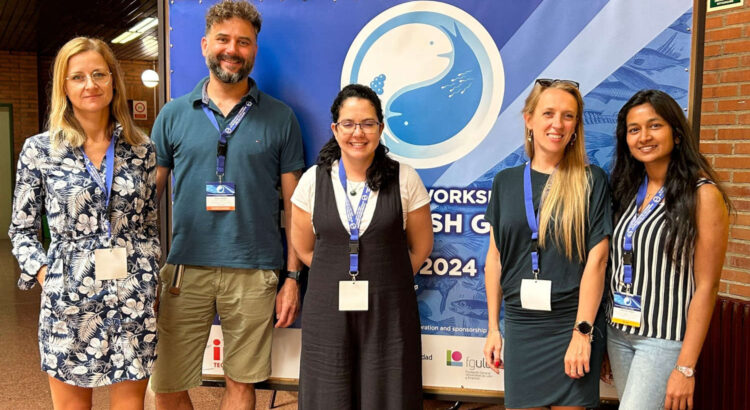
Our researchers at Europe’s most important event on fish gamete biology
The biennial ‘International Workshop on the Biology of Fish Gametes’ conference once again brought together world-class experts in the field of fish reproduction. Scientists met from 15-18 July at the University of León (Spain). This was the 9th edition of the conference aimed on unraveling the biological bases of the reproductive processes, thereby contributing to the improved reproductive efficienecy in aquaculture.
Every two years, the conference successfully brings together research groups from all over the world that study fish gametogenesis, gamete quality, the development of reproductive biotechnologies, the banking of genetic resources, the identification of biomarkers of reproductive performance, etc. For a scientific community dealing with such a narrow and highly specialised topic, this is the most important event of its kind in Europe. Not only does it provide a comprehensive look at the latest research and developments in the field of reproduction of fish and other aquatic organisms, but it also provides an opportunity for collaboration, forging partnerships, and initiating joint scientific projects.
Our Institute was the organiser of the 8th edition of the conference, which took place in Gdańsk in 2022. This year’s edition was attended by 7 researchers from our Institute. Dr. Daniel Żarski, the team leader of emerging Team of Fish Reproduction and Development, was a member of the international scientific committee responsible for shaping the scientific program of the conference and co-chair of the ‘Parental Contribution’ session.
Abhipsa Panda, a PhD student of Dr. Daniel Żarski, pursuing her thesis under the SONATA BIS project, was awarded the prize for the best oral student presentation. The research she presented included an exploration of the relationship between the origin of perch spawners, the quality of the offspring and their transcriptomic profile, which the researchers referred to as the ‘parental dispute’. The results of the presented research were based on unique crosses between wild and domesticated populations, characterised by exceptionally diverse phenotypes and breeding efficiency under laboratory conditions. The data presented by Abhipsa shed new light on the role played by individual perch parents on the ability of offspring to adapt to breeding conditions. ”We are convinced that this research will contribute in the future to optimising breeding procedures not only for perch fish, but also for other valuable fish species,” – explains Daniel Żarski, principal investigator of the project.
Additionally, the team of Daniel Żarski was represented by three more scientists from our institute.
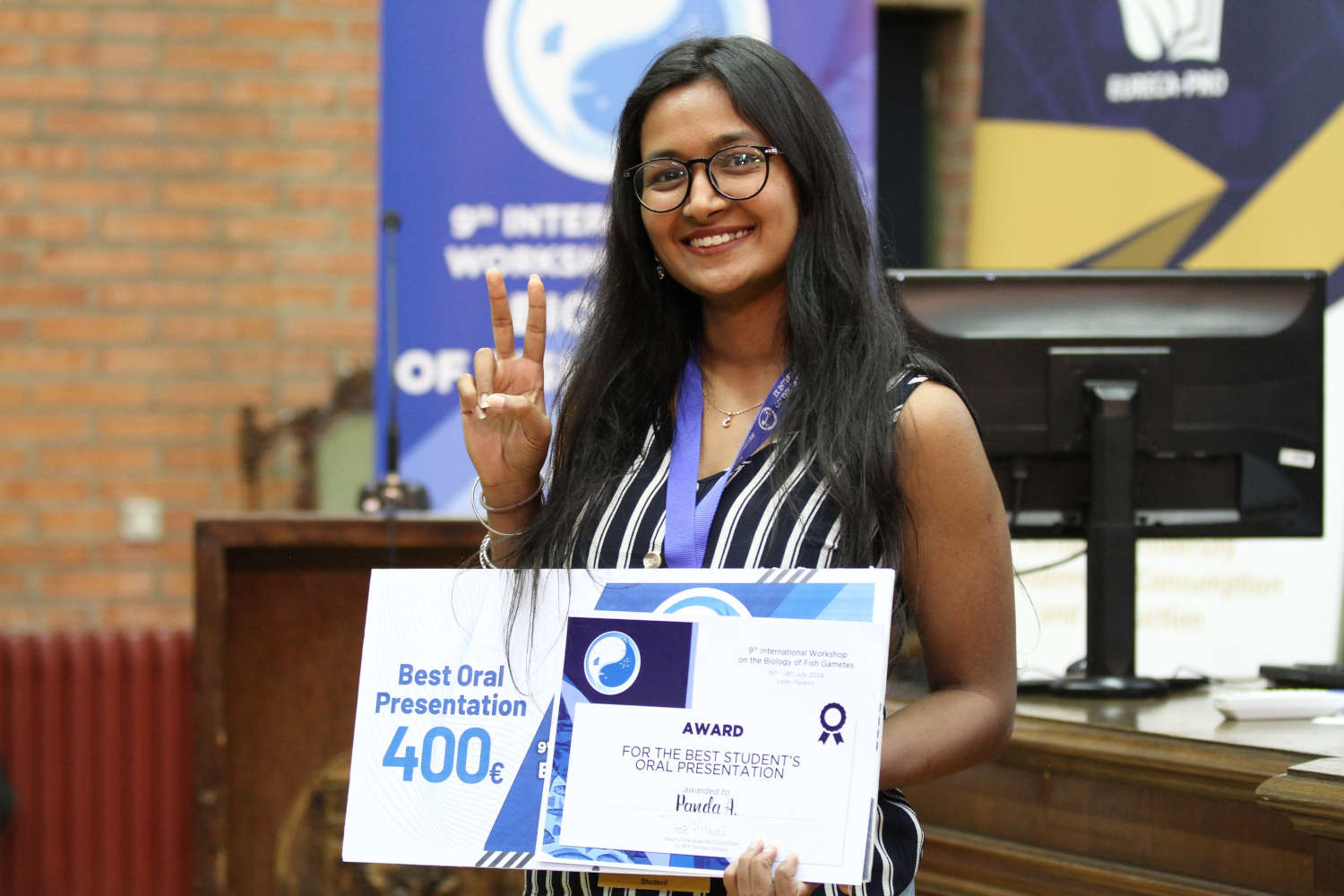
Taina Rocha de Almeida, who is about to complete her postdoctoral training at our Institute, presented groundbreaking data on alternative pathways to build innate immunity in rainbow trout. Her work represents a key contribution to future breeding programmes. Dr. Joanna Nynca delivered a talk on the issue of virginity in wild pikeperch, shedding new light on the reproductive capacity of this species at both zootechnical and molecular levels. Dr. Sylwia Judycka presented the team’s scientific efforts to understand the developmental consequences in perch larvae obtained using cryopreserved sperm. Her poster was highlighted in the ‘flash talk’ session.
It should also be noted that during the conference, two scientists from Professor Andrzej Ciereszko’s team presented their work. Dr. Mariola Dietrich gave a lecture on the impact of cryopreservation strategies on the sturgeon sperm proteome, while Dr. Anna Majewska presented in poster form the results regarding the identification of a previously undescribed protein, Cap31 (SNAD1), and its potential role in the reproductive system of carp.
The active participation of our scientists, especially the first-time awarded oral presentation by a Polish doctoral student, cemented our Institute’s international position in the field of fish reproductive biology, stimulating many constructive discussions. As in previous years, the conference proved to be a highly inspiring event both from a scientific perspective and in terms of collaboration with leading centers across Europe.
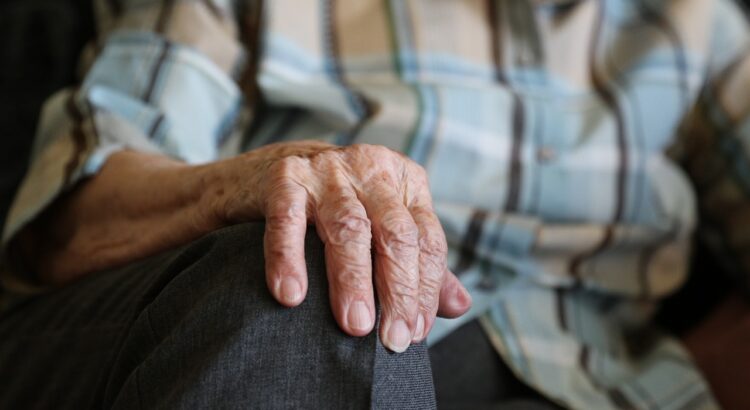
Why and How We Age: The Case of Fanconi Anemia
The aging process in the general population is influenced by various factors, including lifestyle and diet. Certain macro- and micronutrients in our diet interact directly with the human genome, impacting systems such as the immune system. Fanconi anemia (FA), a rare genetic disease, also illustrates the influence of diet on the severity of clinical features. Researchers have explored the connection between these aspects to gain insights into cellular aging.
„We use Fanconi anemia as a prime example of premature aging to illustrate that aging results from an imbalance in our genome—specifically, an imbalance between cellular repair mechanisms and the accumulation of molecular damage,” emphasize Dr. Eunike Velleuer and Prof. Carsten Carlberg, authors of a publication in the journal Nutrients.
What is Fanconi Anemia?
Fanconi anemia (FA) is a rare genetic disorder occurring in approximately one in 300,000 people. It is primarily caused by mutations in 22 different genes responsible for repairing damaged DNA. Individuals with FA often have congenital defects and a high risk of cancers, particularly squamous cell carcinoma of the oral cavity. Due to defects in the DNA repair process, conventional cancer treatments like chemotherapy are ineffective.
A Nutrigenomic Perspective
Aging, unlike FA, is not a disease but a natural process involving the accumulation of molecular and cellular damage, leading to deteriorated function in cells, tissues, and organs. Both the general population and FA patients experience varying rates of aging. While genetics play a role in longevity, lifestyle choices such as diet, smoking, physical inactivity, and environmental factors are significant determinants.
„Nutrition does more than provide essential macro- and micronutrients. Certain food molecules 'communicate’ with our genome and epigenome (chemical modifications to DNA that regulate its function), thereby modulating gene expression in the immune system,” explains Prof. Carsten Carlberg, who leads the Nutrigenomics Team at the Institute of Animal Reproduction and Food Research of the Polish Academy of Sciences.
Fanconi Anemia and Aging
The lifestyle of FA patients, including diet and physical activity, can influence the onset and severity of clinical features. Thus, FA serves as a model for understanding the aging process in the general population. Researchers have demonstrated that non-genetic factors involve cellular disturbances that modulate signal transduction pathways, affecting the epigenome by regulating chromatin-modifying enzymes.
In essence, the balance of genetic and environmental risk factors impacts both cancer onset and aging rates, linked to the transduction of dietary molecule signals. Changes in the epigenome correlate with chronological age and age-related diseases such as cancer. Some individuals may exhibit a 'younger’ epigenome in their tissues compared to their chronological age, while others may have an 'older’ epigenome, correlating with earlier onset of age-related diseases—a pattern observed in premature aging diseases. Conversely, offspring of 'super-aged’ individuals often show a lower epigenetic age in their blood compared to age-matched controls, making epigenetic signatures valuable biomarkers of aging.
„The results of our research benefit not only people with FA but also the general population. By monitoring the aging process at a molecular level, we can develop personalized nutritional or preventive recommendations. Additionally, these epigenetic signatures, being protein-based, could potentially form the basis for drugs that delay or even reverse age-related diseases such as cancer,” the researchers conclude.
—
Learn more about the Nutrigenomics Team of the Institute of Animal Reproduction and Food Research of the Polish Academy of Sciences: https://welcome2.pan.olsztyn.pl/.

Our Institute is leading a major EU project ‘CROSSPATHS’
Developing international cooperation between research units for better use of investments financed by Regional Operational Programmes and creating innovations in the fields of food, health and bioeconomy – this is the main objective of the ‘CROSSPATHS’ project, implemented under Horizon Europe by institutions from Poland, Portugal and Estonia.
The leader of the consortium is the Institute of Animal Reproduction and Food Research of the Polish Academy of Sciences in Olsztyn. The other partners are: Catholic University of Portugal and the Estonian University of Life Sciences. They are representatives of the so-called Widening Countries, i.e. countries where the level of scientific excellence is lower than the European Union average.
Each of the units involved in the project has already benefited from ERDF funds, i.e. funds obtained from Regional Operational Programmes for investment in research infrastructure. All also have experience of obtaining grants from the EU’s Horizon Europe programme.
– The ‘CROSSPATHS’ project will bring together the consortium’s resources and create a group with the unique expertise to provide comprehensive solutions for food technology, health and bioeconomy in European systems. This will enable the group to become a large and significant player on the international stage, specialising in providing innovative food solutions with health-promoting effects and limited environmental impact – emphasises Prof. Mariusz Piskuła, director of the Institute and project coordinator.
The aim of the project’s activities is to develop a joint internationalisation strategy and to launch programmes to build the institutions’ human resources capacities. Staff exchanges, study visits, summer schools, specialised training and courses, and participation in international brokerage meetings are just some of the planned activities. This will strengthen the links of these research units with leading European networks and, consequently, enable them to become desirable partners in Horizon Europe consortia.
The project consortium partners will be supported by a mentoring centre from the Netherlands (Wageningen Research), which will allow them to develop their research management competencies, especially in terms of applying for R&D projects and effectively commercialising the services offered by using EU-funded research investments.
IAR&FR PAS in Olsztyn coordinates the entire project. Within the framework of individual tasks, the Institute is responsible for developing a joint internationalisation strategy, organising international meetings and conferences, and a brokerage meeting in Brussels.
– Involvement in this major international project is an opportunity to showcase the capabilities and potential of our – the country’s leading – research unit outside Poland, and increases the chances of implementing the results of our research in European markets – the coordinator adds.
Funded by the EU funds project will run by the end of April 2026. The total budget is almost €1.2 million.




